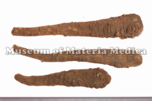Angelica Dahurica Root

|
Market name:一等白芷 Photo location:Museum of Materia Medica, Inst. of Nat. Med. TMPW No.:4569 |

|
Plant name:Angelica dahurica Photo location:Hokkado, Japan Photo date:2001 Photographer:K. Komatsu |
| Synonym | |
| Latin name | Angelicae Dahuricae Radix |
| Botanical source: Family name | Umbelliferae |
| Botanical source: Plant name | Angelica dahurica Bentham et Hooker filius ex Franchet et Savatier (IPNI:60451989-2) |
| Part used | Root |
| Empirical criteria for quality selection | Good one has not been damaged by insects and has a very strong odor. (TN) |
| Constituents | Coumarins: [A. dahurica]: Byakangelicin, Byakangelicol, Oxypeucedanin, Imperatorin, Phellopterin, Xanthotoxin, Marmesin, Scopoletin, Anhydrobyakangelicin, Neobyakangelicol; [A. dahurica var. pai-chi]: Byakangelicin, Byakangelicol, Oxypeucedanin, Imperatorin, Phellopterin, Xanthotoxin, Marmesin, Scopoletin, Anhydrobyakangelicin, Neobyakangelicol, Isoimperatorin; [A. formosana]: Phellopterin, Oxypeucedanin, Imperatorin, Isoimperatorin, Bergapten, Oxypeucedanin hydrate |
| Pharmacological effects | Sedation (decoction), hypertensive action of central origin, acceleration of respiratory movement (ether extract), antibacterial (dysentery bacillus, Salmonella typhi, Gram-positive, Mycobacterium tuberculosis). |
| Indications | As a tranquilizer, painkiller and for draining of pus, it is applied to treat headache, toothache, rhinitis and women's blood trouble. |
| Diseases | Headache, Toothache, Rhinitis, Pyogenic dermatosis, Leukorrhea, Swelling and pain of joint, Itching, Snake bite |
| Formulas | uyakujunkisan , kakkoshokisan , keigairengyoto , goshakusan , shinsentaitsuko , jijintsujito , jijinmeimokuto , jurokumiryukiin , seishitsuketanto , seijokentsuto , seijobofuto , senkyuchachosan , senkin'naitakusan , sokeikakketsuto , takurishodokuin , reitakutsukito , reitakutsukitokashin'i |
| Meridian tropism | Lung, Stomach |
| Property | Warm |
| Flavor | Acrid/pungent |
| Classification in "Shen-non Ben-cao Jing" | Middle |
| TCM: Classification | Diaphoretics |
| TCM: Medicinal effects | To dispel wind, to remove damp, to clear the stuffed nose, to relieve pain, and to promote the subsidence of swelling and to drain pus. Used for headache, pain in the forehead and stuffed nose due to colds, sinusitis, toothache, excessive leukorrhea, swelling and pain of sores and wounds. |
| Remarks | Listed in the Japanese Pharmacopoeia 18th ed. |
| References | TN: T. Namba & Y. Tsuda ed., Outline of Pharmacognosy, a Textbook, 3rd ed., Nankodo Co., Ltd., Tokyo, 1998. |
DNA sequences of medicinal plants
| Gene Region | |||||||||||||||||||
| Nuclear | Chloroplast | Mitochondria | |||||||||||||||||
| Botanical source: Plant name | 5Ss | 18S | ITS1 | 5.8S | ITS2 | 26S | others | trnH-psbA | matK | trnK | trnK-rps16 | trnT-L | trnL | trnL-F | rbcL | rpoC1 | ndhF | others | |
|
|
|||||||||||||||||||
